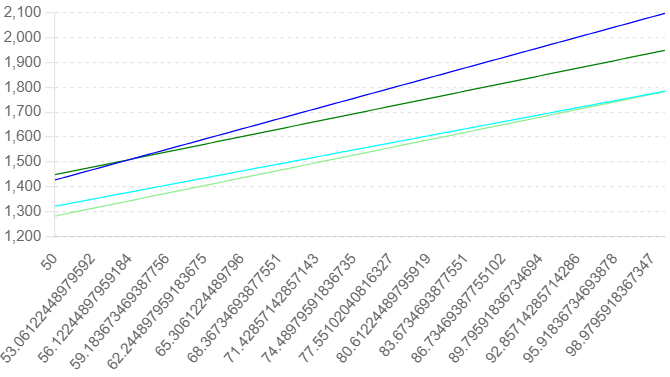Calorie Calculator
Below is a detailed explanation of how a Calorie Calculator works, including the significance of each input parameter and the calculations involved.
Calorie Calculator Explained
A calorie calculator is a tool used to estimate the number of calories a person needs to consume each day to maintain, lose, or gain weight. This estimation is based on several factors, including age, gender, height, weight, and activity level. Here’s a detailed breakdown of each component:
1. Age
Age is a crucial factor in determining calorie needs. As people age, their metabolism generally slows down, which means they require fewer calories. Children and teenagers usually need more calories due to growth and higher activity levels, while older adults need fewer calories as their basal metabolic rate (BMR) decreases.
2. Gender
Gender affects calorie needs due to differences in body composition. Typically, men have more muscle mass and less body fat than women, leading to a higher BMR. This means that, on average, men require more calories than women.
3. Height (cm)
Height is directly related to the overall size of the body. Taller individuals have larger bodies that require more energy to function, thus increasing their calorie needs. The height input is usually in centimeters.
4. Weight (kg)
Weight is a significant factor in determining calorie needs. Heavier individuals burn more calories at rest because their bodies have to work harder to maintain basic functions. The weight input is usually in kilograms.
5. Activity Level
Activity level greatly influences calorie needs because it accounts for the energy expended through physical activity. Most calculators use a scale to represent different activity levels, typically ranging from sedentary to very active:
- Sedentary: Little to no exercise, mostly sitting.
- Lightly Active: Light exercise or sports 1-3 days a week.
- Moderately Active: Moderate exercise or sports 3-5 days a week.
- Very Active: Hard exercise or sports 6-7 days a week.
- Extra Active: Very hard exercise or a physically demanding job.
Calculation Process
The calorie calculator typically uses the Harris-Benedict Equation or the Mifflin-St Jeor Equation to estimate the Basal Metabolic Rate (BMR). BMR is the number of calories your body needs at rest to maintain basic physiological functions like breathing, circulation, and cell production.
Harris-Benedict Equation
For Men: BMR=88.362+(13.397×weight in kg)+(4.799×height in cm)−(5.677×age in years)\text{BMR} = 88.362 + (13.397 \times \text{weight in kg}) + (4.799 \times \text{height in cm}) – (5.677 \times \text{age in years})BMR=88.362+(13.397×weight in kg)+(4.799×height in cm)−(5.677×age in years)
For Women: BMR=447.593+(9.247×weight in kg)+(3.098×height in cm)−(4.330×age in years)\text{BMR} = 447.593 + (9.247 \times \text{weight in kg}) + (3.098 \times \text{height in cm}) – (4.330 \times \text{age in years})BMR=447.593+(9.247×weight in kg)+(3.098×height in cm)−(4.330×age in years)
Mifflin-St Jeor Equation
For Men: BMR=(10×weight in kg)+(6.25×height in cm)−(5×age in years)+5\text{BMR} = (10 \times \text{weight in kg}) + (6.25 \times \text{height in cm}) – (5 \times \text{age in years}) + 5BMR=(10×weight in kg)+(6.25×height in cm)−(5×age in years)+5
For Women: BMR=(10×weight in kg)+(6.25×height in cm)−(5×age in years)−161\text{BMR} = (10 \times \text{weight in kg}) + (6.25 \times \text{height in cm}) – (5 \times \text{age in years}) – 161BMR=(10×weight in kg)+(6.25×height in cm)−(5×age in years)−161

Here is a graphical representation of Basal Metabolic Rate (BMR) calculations using both the Harris-Benedict and Mifflin-St Jeor equations for men and women, with varying weights from 50 kg to 100 kg. The height is fixed at 175 cm, and the age is fixed at 30 years.
Insights from the Graph:
- BMR Differences by Gender:
- For both equations, men generally have a higher BMR than women due to higher muscle mass and different metabolic demands.
- Equation Comparison:
- The Mifflin-St Jeor equation tends to provide slightly higher BMR estimates for both men and women compared to the Harris-Benedict equation.
- The differences between the equations highlight how varying methodologies can impact the estimated caloric needs.
- Impact of Weight:
- As weight increases, the BMR also increases for both genders and across both equations. This is because more energy is required to maintain a larger body mass.
These insights can help individuals understand how their caloric needs might change with different weights and the importance of considering different equations when estimating BMR.
Total Daily Energy Expenditure (TDEE)
Once the BMR is calculated, the Total Daily Energy Expenditure (TDEE) is estimated by multiplying the BMR by an activity factor that corresponds to the individual’s activity level. This gives the total number of calories needed to maintain the current weight.
TDEE=BMR×Activity Factor\text{TDEE} = \text{BMR} \times \text{Activity Factor}TDEE=BMR×Activity Factor
The activity factors are generally as follows:
- Sedentary (little or no exercise): BMR ×\times× 1.2
- Lightly active (light exercise/sports 1-3 days/week): BMR ×\times× 1.375
- Moderately active (moderate exercise/sports 3-5 days/week): BMR ×\times× 1.55
- Very active (hard exercise/sports 6-7 days a week): BMR ×\times× 1.725
- Extra active (very hard exercise/physical job): BMR ×\times× 1.9
Practical Example
Let’s consider an example to see how the calculation works in practice.
Example:
- Age: 30 years
- Gender: Male
- Height: 180 cm
- Weight: 75 kg
- Activity Level: Moderately active
Using the Mifflin-St Jeor Equation:
BMR=(10×75)+(6.25×180)−(5×30)+5\text{BMR} = (10 \times 75) + (6.25 \times 180) – (5 \times 30) + 5BMR=(10×75)+(6.25×180)−(5×30)+5 BMR=750+1125−150+5\text{BMR} = 750 + 1125 – 150 + 5BMR=750+1125−150+5 BMR=1730 calories/day\text{BMR} = 1730 \, \text{calories/day}BMR=1730calories/day
Then, calculate TDEE for a moderately active person:
TDEE=1730×1.55\text{TDEE} = 1730 \times 1.55TDEE=1730×1.55 TDEE=2681.5 calories/day\text{TDEE} = 2681.5 \, \text{calories/day}TDEE=2681.5calories/day
Therefore, this person needs approximately 2681.5 calories per day to maintain their current weight.
Conclusion
A calorie calculator is a useful tool for estimating daily caloric needs based on individual characteristics and activity levels. Understanding the inputs and the calculation process can help individuals better manage their diet and achieve their health and fitness goals.